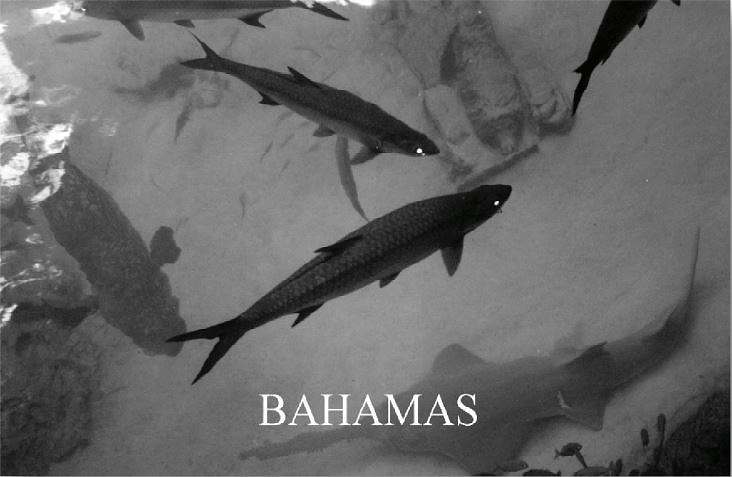
February 2005
As a freelance interpreter, my son Selim received an offer to work on Paradise Island in the Bahamas. A colleague had recommended him to interpret from English into Greek for an international meeting of Serono, a biotechnology company. Selim accepted, giving me the opportunity to meet up with him on Paradise Island as a respite from Boston’s winter weather.
The week before my departure it snowed nonstop for almost 24 hours, leading to the greatest monthly accumulation of snow in over 100 years. Subsequent sunshine, followed by sub-zero temperatures, created a natural skating rink in my driveway. To catch an 8 am flight, I left the house at 5:30. I could make out icicles hanging from the gutters in the morning twilight. As I made my way to the street, taking very tentative steps in order not to fall, I tried to imagine that I was walking on wet sand rather than icy concrete.
The airport shuttle bus was packed with Hispanic staff, bundled up on their way to work. How miserable they must feel in this cold climate, I thought. Since it was early Saturday morning, there were few passengers, giving security personnel ample time to be thorough. As we shed our jackets, I noted passengers in Serono T-shirts displaying their red, white, and blue colors on the occasion of the company’s 100th anniversary.
Since I left the house so early in the morning, I had no time for breakfast and thought we would certainly have something to eat during our three-hour flight. I was wrong. Because airlines are trying to trim back expenses, all we had was a choice of caffeine, juice, or soft drinks accompanied by a bag of low-fat pretzels. I felt ravenous and regretted that I had not packed a snack. Yet as soon as we landed in 78º F weather, I forgot my hunger.
The conference staff, clad in red T-shirts, were at the airport in full force, ready to meet 1200 delegates on Saturday and another 1500 on Sunday. Since Selim was not due to arrive for another three hours, I decided to identify myself as the mother of one of the interpreters and was quickly ushered into a van going to the Riu, a five-star hotel next to the Atlantis, a huge hotel and convention center, where the conference was to be held. The fourteen-mile way from the airport goes through downtown Nassau before connecting to a bridge to Paradise Island. Our driver acted as a guide as we passed by colonial landmarks, such as the Straw Market, as well as countless diamond and emerald shops, which attract tourists from cruise ships, as Nassau is a duty-free port.
The last time I had been in Nassau was in the early 70s, when Paradise Island was an undeveloped piece of land, rather than the resort for the wealthy it is now. As our van crossed the bridge, we saw high-rise hotels, including the Riu, dotting the skyline. Even the taxicabs on the island seemed to be fancy limousines. Somewhat ill at ease amidst the luxury, I entered the hotel lobby.
A friendly receptionist welcomed me by name to the hotel, which was to be the home base for 36 interpreters arriving from nine different countries. She strapped a white plastic band onto my wrist, instructing me not to take it off until my departure. This was the magic band that would provide free entry to all hotel facilities for the next 6 days. Courtesy of the General Manager, I could eat and drink all I wanted for a daily supplement of $75, which even included the minibar in our room. Was this a reverence gesture for motherhood? Somewhat in disbelief, I took the elevator to check out the room.
Our spacious room on the 9th floor had a balcony with an ocean view. I stepped out into the afternoon sun to soak up the warmth and enjoy the panorama. The contrast to the deep freeze and icicles I had left behind was surreal. Before me were palm trees swaying in the wind. Remembering that I had not eaten in a while, I went back in to locate the minibar. A big square box on the floor, it was packed with soft drinks and a gallon of bottled water. Thinking I might find some food, I opened the wall unit above it. Much to my surprise, I found five quart-size liquor bottles mounted upside-down with spigots. The selection included dark and light rum, gin, vodka, and whiskey. It was not difficult to imagine the flow of liquor during room parties.
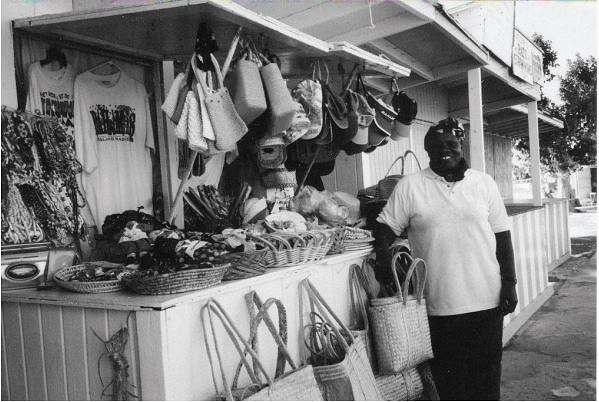
Straw market
Still hungry, I decided to locate the restaurant. This was a big room with a terrace overlooking the swimming pool, where hotel guests were surrounded by loud soca music from the bar. The lunch buffet offered a salad bar, a pasta station, a variety of exotic Bahamian fare such as grouper stuffed with plantains, a fish fry, and many meat dishes, including hamburgers and hot dogs. The desserts ranged from cakes and cookies to fruit and ice cream with a choice of sauces. I walked out to the terrace with a very full plate, which I justified to myself since I had skipped breakfast. The waiters were very attentive, whisking away my dirty dishes in between each course.
Discouraged by the poolside noise, I decided to wait for Selim in the room. We were accustomed to meeting in hotel rooms after separate flights, having done so before in Havana and Bangkok. As I stepped out of the elevator I ran into Selim, who was very relieved to see me. The afternoon reception crew had told him that his mother had not checked in yet, thus causing him stress. Happily united, I was grateful that we felt so connected as mother and son.
Selim had two bands on his wrist — a white one like mine and a blue one for entry to the conference hotel, the Atlantis. After some rest we decided to check out the facilities next door. By now it was dark, and the Atlantis glowed in lights as we approached. People in evening dress were streaming in from the different towers of the mega-complex, headed for the casino. A shopping alley lined with luxury stores such as Bulgari, Gucci, and Aaron Basha — the latter displaying baby shoes in 18-carat gold with diamonds and enamel in its window — led the way to the casino. Along the way were lobbies with ostentatious light fixtures and kitschy wall decor. Inspired by Las Vegas, this hotel was determined to beat its American model in expensive garishness. Furthermore, its marketing and sales people were eager to sign people up for a free tour of the entire complex, including breakfast normally valued at $75, to encourage them to consider buying a timeshare unit in this paradise. Declining the offer, we went to see the casino. Its decor surpassed all ostentation we had seen; the ceiling fixture of red glass appeared aflame over the game tables. Feeling underdressed for the setting, we returned to our hotel for dinner.
The following morning Selim and I went for a walk on the beach, since he had the day off before commencing work on Monday. The turquoise sea lapped the shore with its heavy surf, as we followed the coastline of bleached white sand. Red flags on all beachfront hotels signaled danger, discouraging swimmers from going into the rough waters.

At Ardastra Gardens
Heeding the caution, we decided to go to Ardastra Gardens, a zoo and conservation center in Nassau. Selim’s colleague Eva joined us on this trip, which turned out to be delightful for all of us. We strolled through lush tropical plants; became acquainted with exotic mammals, birds, and reptiles from the Bahamas and the rest of the Caribbean; and watched a show of marching flamingos. My favorite part was feeding apples to the lory parrots. Red and green parrots flocked around me, landing on my hand to peck at the fruit. Each parrot finished an eighth of an apple down to its skin, while others waited their turn perched on my head, shoulders, or arms. This was a delightful sight for a photo; we tried to take pictures of each other, holding a camera in one hand and a piece of apple in the other.
On the way back we took the bus to downtown Nassau to see the Straw Market, where craftspeople sell their wares. When we inquired where the bus stop was, the answer was “Just wave it down, it will stop for you,” and indeed it did! The Straw Market takes its name from the material used to make goods on the premises: dolls, doilies, place mats, handbags, beach bags, and baskets of all sizes and shapes. We watched women decorate bags by putting paper patterns over them and hand-stitching over the lines with colorful raffia. When finished, they tore off the patterns, exposing bold flower designs inspired by the island flora. Hawkers tried to draw our attention by calling out “Your price is my price!” Selim bought a turtle made of coconut shell for Iris. Sold by a young child, the turtle walked when a string wound around a spool under its shell was pulled.
In the evening we had a choice of a self-serve buffet and three restaurants – Japanese, Gourmet, and a Steak House, which also featured seafood. Serving by reservation only, these restaurants offered a choice of two shifts, 6:30 or 8:30 pm, with a dress code forbidding short-sleeved shirts for men. We were able to try all three; my favorite was the Gourmet restaurant, where I had grilled snapper. It was simply delicious. In all the restaurants wine and after-dinner drinks flowed freely, courtesy of our armbands. Sometimes Selim’s colleagues joined us for dinner, giving me a chance to meet these talented linguists who worked in different language booths: Chinese, Japanese, French, German, Greek, Italian, Portuguese, Spanish, and Turkish.
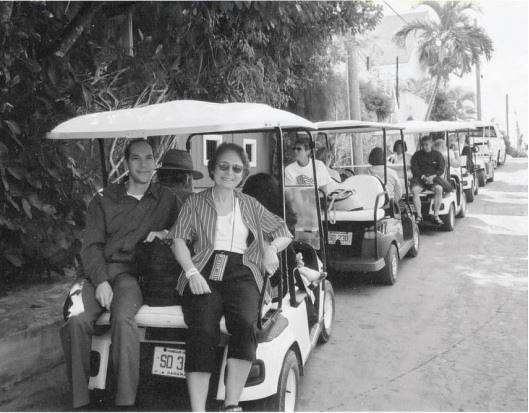
Touring Harbor Island
One evening the interpreters decided to eat out as a group and chose to go to a restaurant patronized by locals. Arawak Cay, home to one of Nassau’s famous forts built in 1787 at the western entrance to the Harbor, is lined with quaint fish restaurants where natives hang out after work for eating, drinking, and girl watching. Based on recommendation, our choice was the restaurant at number 10. We largely took over the small outdoor deck because of our size — eighteen interpreters plus two husbands, and of course a mother. We enjoyed conch chowder, fish fry, and local beer.
In the middle of the week Selim had a day off, as concurrent conference sessions were being conducted in English without interpretation. We opted to go to Harbor Island, known for its pink sand and unspoiled charm. Hiromi, a colleague of Selim’s, and her husband, as well as Kevin, another friend, joined us for a day tour of the island offered by Bahamas Ferries. The two-hour boat ride required an early start for the five of us, as the fast ferry departed from Nassau Harbor at 8 am. Our ride was mostly smooth with a few bumpy segments, which were over before any of us felt seasick.
A young woman with tight thin braids framing her head met us at the landing and introduced herself as our guide. Following a historical overview, we piled into golf carts for a tour of the island, stopping at landmarks dating back to the 1800s. Pastel-colored colonial buildings with unique corner architecture and open balconies were noteworthy. We had lunch vouchers for three different restaurants; we chose the one closest to the beach. Following an enjoyable native seafood lunch, we spent the rest of our time on the beach, some of us walking on the pink sand and others swimming. We took the same ferry back at 4 pm.
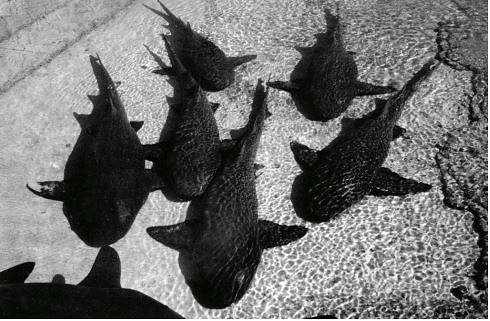
Aquarium at the Atlantis Hotel
One morning I decided to explore the grounds of the Atlantis Hotel, which often uses the slogan “Move over Las Vegas” in its promotions. At the time the most beautiful part of the hotel was the grounds. The clarity and beauty of the surrounding water came straight into the swimming pools, as well as into a huge aquarium and marine habitat featuring most denizens of Bahamian seas, including a large manta ray, sharks, giant turtles, crawfish, and reef fish. There were beautiful flower gardens, waterfalls, and walking paths. However, the plans were to turn the outdoor attractions into a huge theme park to entertain millions of cruise ship passengers, in addition to hotel guests. Kerzner International, the developer of the resort, was spending billions on high-tech thematic river rides and water slides, in addition to a new 1500-room hotel with the look of a Mayan temple, next to the existing complex. When completed in 2006, the project was to create 3000 full-time jobs, adding up to 5% annually to the national economy.
The life blood of the Bahamian economy is tourism and investment. The islanders bend over backwards to attract wealthy people to visit and invest. Curious to see where the natives lived, I inquired about a tour that would take me around to the residential parts of the island. “They are all outside of Nassau. You would have to pay for a private tour,” said the booking agent at the desk.
Fortunately, a Bahamian friend in the States had given me the name of someone who lived on the island, in case I needed a local contact. Her name was Corinne. I contacted her and expressed to her my deep desire to see where ordinary people lived. She offered to take me on a tour of New Providence Island, which includes Nassau, the nation’s capital.
Leaving work in the mid-afternoon, Corinne drove me around, following the coastal road. She first pointed out the homes of super-wealthy people such as Oprah Winfrey and Michael Jackson on Paradise Island, and then those of the Bahamians, descendents of colonial families, on New Providence. There are also gated homes of foreign investors such as the owner of Kay Jewelers, as well as people who have become wealthy overnight due to the island’s strategic location for drug trafficking. As the educated population grows, so do the numbers of professionals like doctors, lawyers, and bankers who move into gated communities of their own.
We also drove by government-subsidized housing for low income families. Some were well maintained and others badly neglected. We saw many school children in neat uniforms, waiting on every block for a bus to pick them up. While such pickups are very convenient for the children, they are frustrating for drivers stuck in traffic behind a bus on a narrow road. Traffic is a problem for commuters, as all interior roads lead to one main road that circles the island. Every high school graduate’s dream is to own a car. Taxi drivers own their passenger cars or limousines; many of the cabs are driven by women.
Life in the Bahamas is expensive, as most goods are imported. Bananas, mangoes, citrus fruit, corn, yams, and a few other root vegetables are the basic locally grown produce. One of the treats of this tour was a visit to the farm of Corinne’s parents, where she had grown up. Referring to the farm as the “sanctuary,” she gave me an introduction to tropical plants as we walked around. It is here that I first encountered a calabash tree, which Corinne’s father had imported from his native island of Dominica. I commented on the numerous dogs around us. For security reasons, Corinne’s parents owned four dogs, and her two brothers, who also lived on the farm in separate homes, had six dogs each. Should one dog be shot by an intruder, the others would continue barking and wake up the household, Corinne explained.
Although there is unemployment on New Providence Island, the poverty I had observed during my first trip in the 70s appeared to be gone. The island’s poorest population group consists of Haitian refugees, who have come to find work or who use the Bahamas as a stepping stone to the US. Most of these refugees work on construction sites or do menial work. Their English tends to be poor, since their native tongue is French Creole.
Thanking Corinne for this most informative tour, I returned to the hotel. Corinne even knew who the mystery celebrity speaker at the Serono gala dinner that evening was to be. Even though the interpreters had been asked to work for an hour during the dinner, they were not given the name of the speaker for reasons of security. It turned out to be former US President Bill Clinton. Selim was very impressed with Clinton’s speech and was glad to have the opportunity to interpret it into Greek, taking turns with his colleague Eva.
Around noon on Friday I left Paradise Island for my return trip home. Lingering memories include the smiling faces of the islanders, their gentle gait, and the variety of fresh fruit juices at breakfast every morning, as well as the hotel spa with its sauna and hot tub, which would help me get through the rest of the winter. When I arrived at Boston’s Logan Airport, everyone around me appeared to be running — why or where to I did not know.
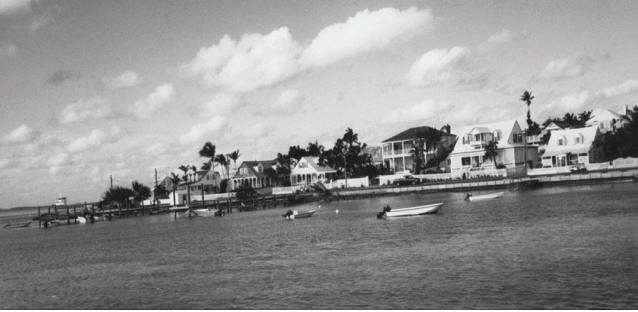
Harbor Island
← Egypt
